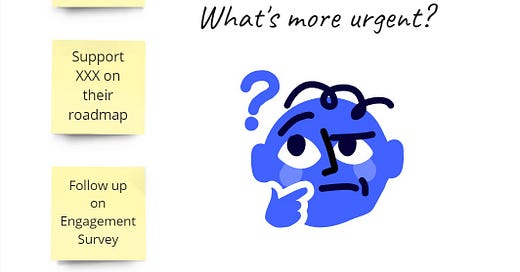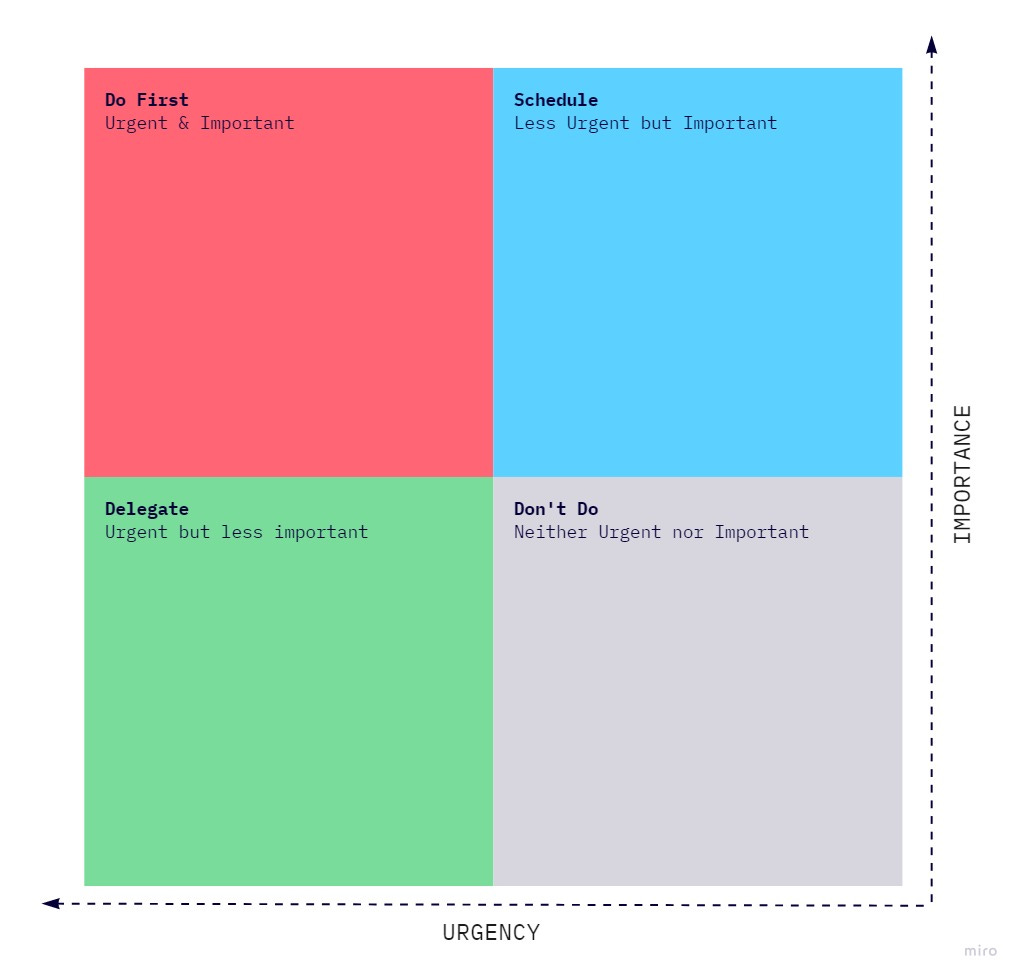Tame your priorities with this simple two-by-two matrix
Eisenhower and Covey popularized this approach years ago, and it still works!
Have you ever struggled with what’s on your plate, not knowing what to do first? How about that thing you’re supposed to get done, but there’s always a new fire popping up demanding your attention? Enter the Eisenhower or Covey 2x2 prioritization matrix.
We are often caught in urgent work that is ultimately not important, and we rarely get to the important things that aren’t urgent. This visualization forces us to be honest about our work and overcome these failure modes. Make no mistake though, this approach requires discipline, and while it may be simple, it is not easy to stick to your important, scheduled work in the future.
How to use the 2x2 matrix effectively
If you’re not quite sure what projects, actions, or work is actually on your plate, you might want to do a brain dump first.
Once you have a list of what’s on your plate, go through this simple process until all of your work has been added to the matrix.
Grab your first item, for example, “Share Feedback on Product Vision”
Do a quick gut estimate of how urgent and important this piece of work is. Avoid wasting a lot of time on getting the perfect estimate. Done is better than perfect!
Place the item in the right quadrant.
Repeat this process with your other todos.
If two items seem similar in urgency and importance, make a quick decision on which seems more urgent or more important right now. Again: Don’t waste a lot of time on this.
While going through your work you may rearrange the items on the matrix, but keep an eye on their relative position.
Continue until all of your work has been placed.
💡 This whole activity should take 30 minutes at most because the urgency and importance of each item might naturally change just a few hours or a day later. Maybe your manager makes an urgent request, or you learned just how valuable one of your projects is for your organization or customers. The purpose of this activity is to tame the chaos inside your head and get the right things done, not to create a perfect, robust, long-term plan.
Tips for ranking and ordering
While you’re probably good to go through this activity, I’d like to share a few learned lessons on the topics of urgency and importance.
Don’t confuse loud with urgent. Just because someone is pushing you via email or chat, doesn’t mean you have to jump to fulfill their request this very moment. Make it a habit to ask “Until when do you need this?” to get more clarity on urgency.
Urgency and importance are flexible. A piece of work might seem irrelevant today, but super urgent or important tomorrow. It might also change depending on who you ask. I’d recommend going with your best guess most of the time, because you have a much better idea about your role, goals, and contribution to your company’s success.
Note your knowledge gaps. Going through this exercise may show you many gaps in your knowledge. This can make it hard to effectively sort and order your work, but my advice is to go with your gut for now. If you don’t know how urgent or important something is at all, take note of it and consider who you might ask about it. These gaps can also be great starting points for research.
Using your finished 2x2 matrix effectively
When you’re done with the activity, each quadrant already prescribes what you should do with each piece of work.

Do First: This work is urgent and important, so do it as soon as possible. Make sure to reflect regularly if this kind of work was actually as urgent and important as it seemed at the time - you might be surprised.
Schedule: This work is less urgent but important. The guidance is to schedule it in your calendar when there’s sufficient time. It’s absolutely crucial to stick to these commitments as the pressure of “fighting fires” can be immense.
Delegate: This work is urgent but less important, so it’s ideal for delegating. Delegating will help your direct reports to grow, and give you the space to work on other important things.
Don’t Do: This work is neither urgent nor important enough to deserve your time right now, so don’t do it. Be mindful that this may change in the future.
💡 Don’t hesitate to share the matrix with your manager, peers, or team. This can be a brilliant way of managing upward and aligning with your boss on your priorities. This can also make it clearer to your peers what you will focus on (or not). The same goes for your team too.
What to do if you can’t delegate
This newsletter is aimed at leaders, but this technique works wonders for individual contributors too. The only issue is that you don’t have people you can delegate work to, so what can you do instead? Here are a few options to consider:
Don't Do: Depending on the kind of work you might get away with simply not doing it at all. This requires experience though, as it can also backfire. Mistreat an important stakeholder or your manager once and you may be in trouble. If the risk is low, you may simply wait until you get a “friendly reminder” on a work request or action item. Don’t be surprised though if you never hear about this “super urgent” topic again.
Special Schedule: A common strategy is to schedule a daily blocker for urgent but unimportant work. Giving this kind of work at least some place no your calendar may be a necessary evil to avoid worse scenarios (like dissatisfied stakeholders, managers, or colleagues). The difference to the “Schedule” strategy above is that you’re not scheduling time to advance one specific project, hence the “Special”.
Do If Free: Not much to explain here, if you have the time anyway, you might as well decide to do this urgent but unimportant work. Maybe it will help strengthen a working relationship at least?
Where I learned this
This concept is often attributed to former US President Eisenhower or Stephen Covey. In Covey’s “7 Habits of highly effective people”, the third habit describes the technique in detail. Even Eisenhower attributed the idea to an unnamed college president, so the true origin is unknown.






